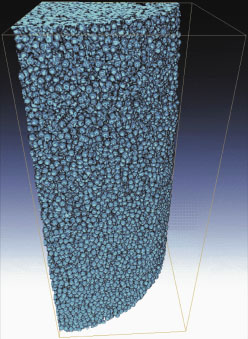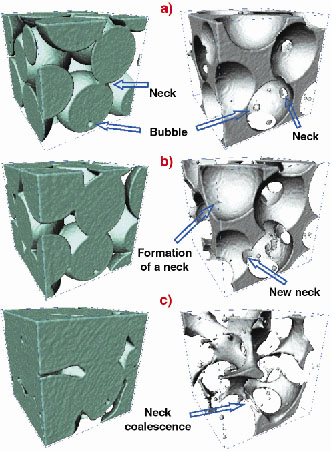- Home
- Users & Science
- Scientific Documentation
- ESRF Highlights
- ESRF Highlights 2001
- Applied and Industrial Research
- First Direct 3D Visualisation of Microstructural Changes During Sintering
First Direct 3D Visualisation of Microstructural Changes During Sintering
Sintering is the material preparation process that allows densification of powders at temperatures lower than their melting point. Mass transfers that take place to minimise surface energies induce various microstructural changes such as intergranular porosity disappearance and grain growth. Since the sixties, much research has been done to understand and model sintering phenomena. The data collected for those studies came from large-scale techniques or was obtained by averaging 2D measurements. Consequently, predictions of densification phenomena are generally limited to the case of ideal grain arrangements [1]. Recent developments of the X-ray computed microtomography technique opened the path to non-destructive 3D characterisation at the micrometre scale of samples during sintering, offering an entirely new viewpoint for sintering mechanisms analysis.
The material considered was a soda-lime glass powder constituted of spherical particles (average diameter of 120 µm). This size was chosen to have a significant number of spheres in the X-ray beam while a high voxel resolution was kept (2 µm). Isothermal sintering treatments and microtomography measurements were performed sequentially on pre-sintered samples at ID19.
 |
Fig. 147: 3D image of the CT-reconstructed volume of a quarter of a pre-sintered sample. |
A 3D reconstructed image of a quarter of a sample in the initial state (pre-sintered) is presented in Figure 147. Grains appear as spheres lightly connected to each other which is the typical microstructure of a powder compact at the very beginning of sintering. More complete measurements have been obtained from a given sub-volume of the compact (200 x 200 x 200 µm3), extracted from the sample at different times. The 3D microstructural evolution of that sub-volume during sintering is illustrated in Figure 148, for the solid part (left) and the porous part (right). These views give an unprecedented description of the 3 stages of sintering. First stage (a): formation of necks between particles and grain rearrangement without pore elimination. Second stage (b): neck growth, changes in grain shape and pore elimination. Third stage (c): final densification and pore closure. Such images clearly depict the complex geometrical changes that take place all along the sintering process; the classical description of pores as cylinders in the intermediate stage is quite far from reality.
 |
Fig. 148: Morphological evolution of the solid phase (left) and of the porosity (right) as a function of sintering time. (a) ts = 20 min., (b) ts = 120 min., (c) ts = 270 min. |
Some relevant parameters relative to sintering phenomena have been extracted from these images. For example, porosity evolution has been calculated both in the whole sample and in the sub-volume in order to study the influence of large packing defects on surrounding particles during densification. More interesting is the time evolution of neck connecting particles. First results suggest that necks formed during the process increase in the same way as those that were initially present. Accordingly, neck growth can actually be described using a unique law within that glass material. This observation agrees with numerical calculations performed on such glass powder systems [2] showing that, at least at the beginning of the process, neck growth is mainly governed by the local minimisation of surface energy and is almost independent of the grain surroundings.
This conclusion must be reinforced by more global and precise analysis of the data, but it clearly reveals the potentiality offered by this technique.
References
[1] R.M. German, Sintering theory and practice. Wiley-interscience publication, ed. John Wiley & sons, New York (1996).
[2] D. Gendron, Numerical and experimental study of sintering at the grain scale, PhD. Thesis, University Bordeaux 1 (2001).
Authors
D. Bernard (a), D. Gendron (b) and J.-M. Heintz (a)
(a) Institut de Chimie de la Matière Condensée de Bordeaux, CNRS, Pessac (France)
(b) CERMEP, Grenoble (France)



